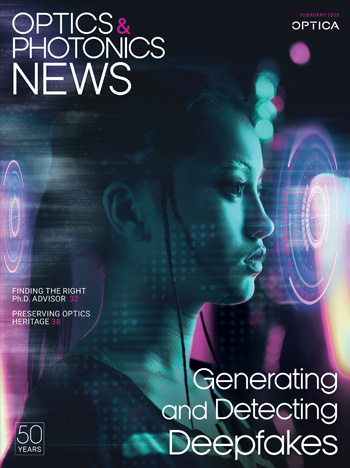
March 2007 Issue
Feature Articles
Terahertz Technology: A Land to Be Discovered
Terahertz technology holds great promise for wireless communication and imaging applications, such as security checks of people, mail or luggage, quality control of pharmaceutical or polymeric goods and clinical diagnostics.
by Martin KochA Twin Photon Source Based on All-Optical Fiber
The most important question in cryptography is how to ensure the security of a message between its sender and receiver. A quantum approach is desirable because detecting and duplicating a photon’s quantum state—that is, sending a message and keeping a copy— is prohibited by the laws of quantum mechanics. A new light source brings quantum cryptography closer to reality.
by Jingyun Fan, Alan Migdall and Lijun WangAll-Optical Signal Processing by Fiber-Based Parametric Devices
Parametric devices based on four-wave mixing in fibers enable the amplification, frequency conversion and phase conjugation of optical signals. They can also be used to monitor, regenerate, switch and buffer signals.
by Colin J. McKinstrie, Stojan Radic and Alan H. GnauckDynamic Photonic Crystals
When dynamic behaviors are introduced into photonic crystal systems, fascinating new possibilities emerge. For example, the bandwidth of a pulse can be completely compressed to zero, resulting in on-chip all-optical stopping and storage of light pulses.
by Shanhui Fan, Mehmet F. Yanik, Michelle L. Povinelli and Sunil SandhuDepartments and Columns
Optics in Armenia
The Republic of Armenia is a landlocked mountainous country in the Southern Caucasus, between the Black Sea and the Caspian Sea. It shares borders with Turkey, Georgia, Azerbaijan and Iran. Despite a population of only 3 million people and a tenuous economy, scientists in this former Soviet republic are conducting world-class optical research on a broad scale.
Breathing New Life into Biomedical Markets: The Story of Arcturus Bioscience
How Arcturus Bioscience went from one-man show to a diverse, market-leading business worth tens of millions of dollars in fewer than 10 years.
Blue-Light Special for Atomic Clocks
Researchers at JILA at the University of Colorado managed to improve the signal-to-noise ratio in a new clock based on a strontium transition.
Honorary OSA Members of the 1920s and 1930s
Profiles of four optical pioneers.
Photonic Crystals: What’s in a Name?
The progenitor of the term “photonic crystals” discusses its history and reflects on its use—and occasional misuse—within the optical community.
Did You Know?
Researchers described an optical system that provides wide-angle images with very little distortion, using both a mirror and lens.
Drilling Opals to Create Optical Cavities
Researchers demonstrated a way to modify the shape of particles on the surface of the opal structure—specifically, to drill a very fine hole into a single nanosized particle.

![Illustration of a synapse in the brain. [Getty Images]](https://opnmedia.blob.core.windows.net/$web/opn/media/images/articles/2025/0425/departments/202504-cover-web.jpg?ext=.jpg)
![Fiber draped around a hand, demonstrating its flexibility. [Photo by Z. Wang and L. Wei]](https://opnmedia.blob.core.windows.net/$web/opn/media/images/articles/2025/0325/departments/202503-cover-web.jpg?ext=.jpg)
